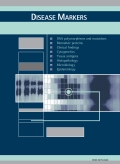Authors: Antczak, Adam | Piotrowski, Wojciech | Marczak, Jerzy | Ciebiada, Maciej | Gorski, Pawel | Barnes, Peter J.
Article Type:
Research Article
Abstract:
Exhaled breath condensate (EBC) has been increasingly used as a new and non-invasive method to study airway inflammation. In this study we have compared the concentrations of lipid mediators in EBC with concentrations in bronchoalveolar lavage fluid (BALF). We included 37 patients undergoing bronchoscopy (12 sarcoidosis, 12 COPD, 6 lung cancer, 5 chronic cough, 1 Wegener's granulomatosis, 1 sclerodermia). Patients were not allowed to have exacerbation or any change in concomitant medication for at
…least 4 weeks prior to the study. In all patients, EBC was collected immediately prior to the bronchoscopy. The levels of cys-LTs, LTB_{4} , 8-isoprostane were significantly higher in BALF compared to EBC (p < 0.0001, p< 0.001, p< 0.0001 for cys-LTs, LTB4, 8-isoprostane respectively). Moreover, there was a strong positive correlation between both leukotriene B_{4} and 8-isoprostane in BALF and EBC (r=0.53 and r=0.79, p< 0.01, respectively) in patients with sarcoidosis and COPD but there was no correlation between eicosanoids BALF and EBC in patients with chronic cough and lung cancer. This is the first study to compare EBC and BALF in different lung diseases which demonstrated significant correlations between the levels of eicosanoids in BALF and EBC in patients with COPD and sarcoidosis. EBC may be useful in measuring inflammation in several inflammatory lung diseases.
Show more
Keywords: Cysteinyl-leukotrienes, 8-isoprostane, prostaglandin E_{2}, exhaled breath condensate, bronchoalveolar lavage, bronchoscopy
DOI: 10.3233/DMA-2011-0776
Citation: Disease Markers,
vol. 30, no. 5, pp. 213-220, 2011
Price: EUR 27.50





